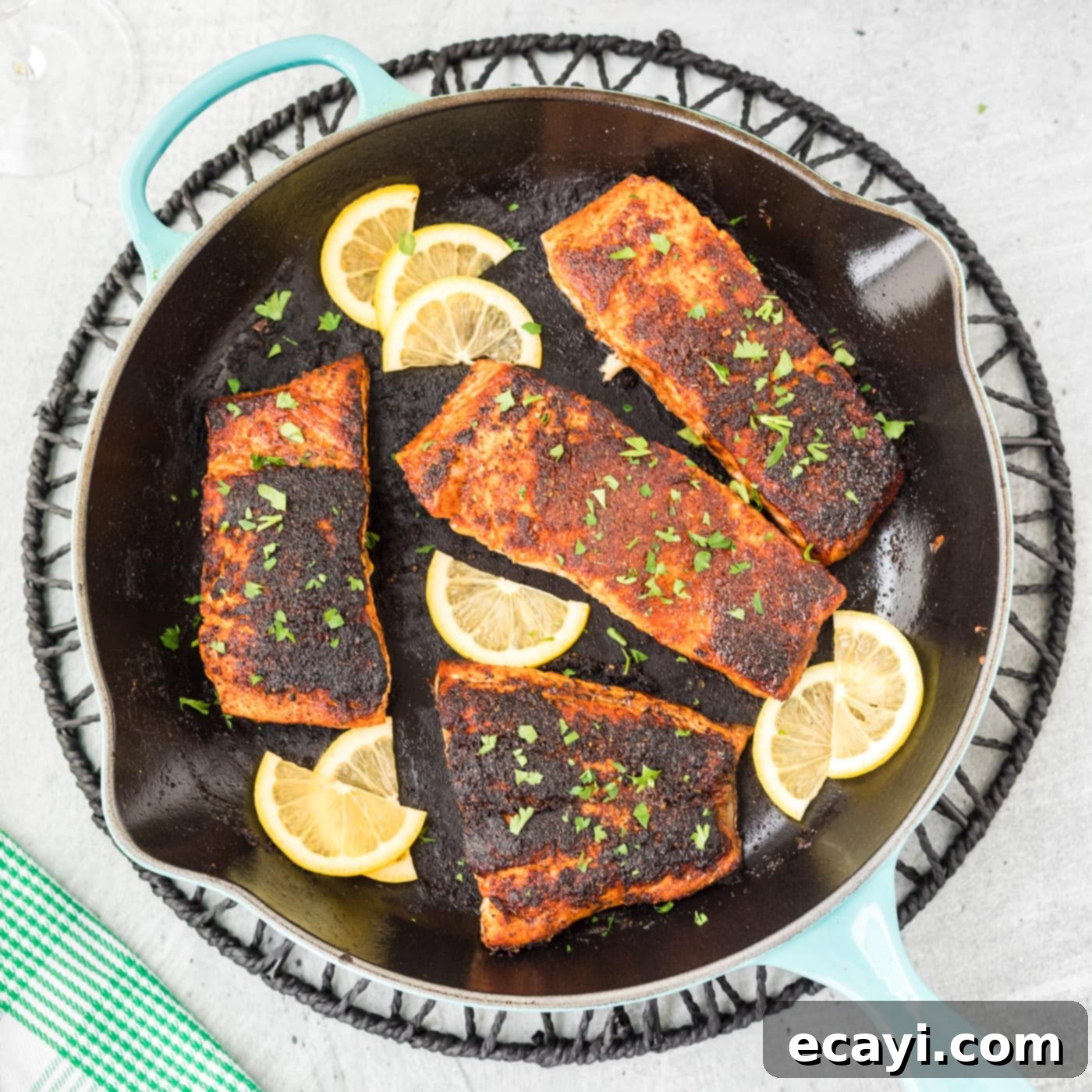Perfect Pan-Seared Blackened Salmon: Your Ultimate Guide to a Flavorful & Healthy Meal
Prepare to elevate your dinner experience with this exceptionally bold and flavorful blackened salmon recipe. Each tender, flaky filet is pan-seared to perfection, creating an irresistible crispy crust that locks in moisture and taste. This impressive dish isn’t just a treat for your palate; it’s also incredibly quick and easy to prepare, coming together in under 20 minutes. Whether you’re a seasoned chef or a beginner in the kitchen, this salmon recipe is designed for effortless success, offering a healthy and delicious meal solution for any night of the week.
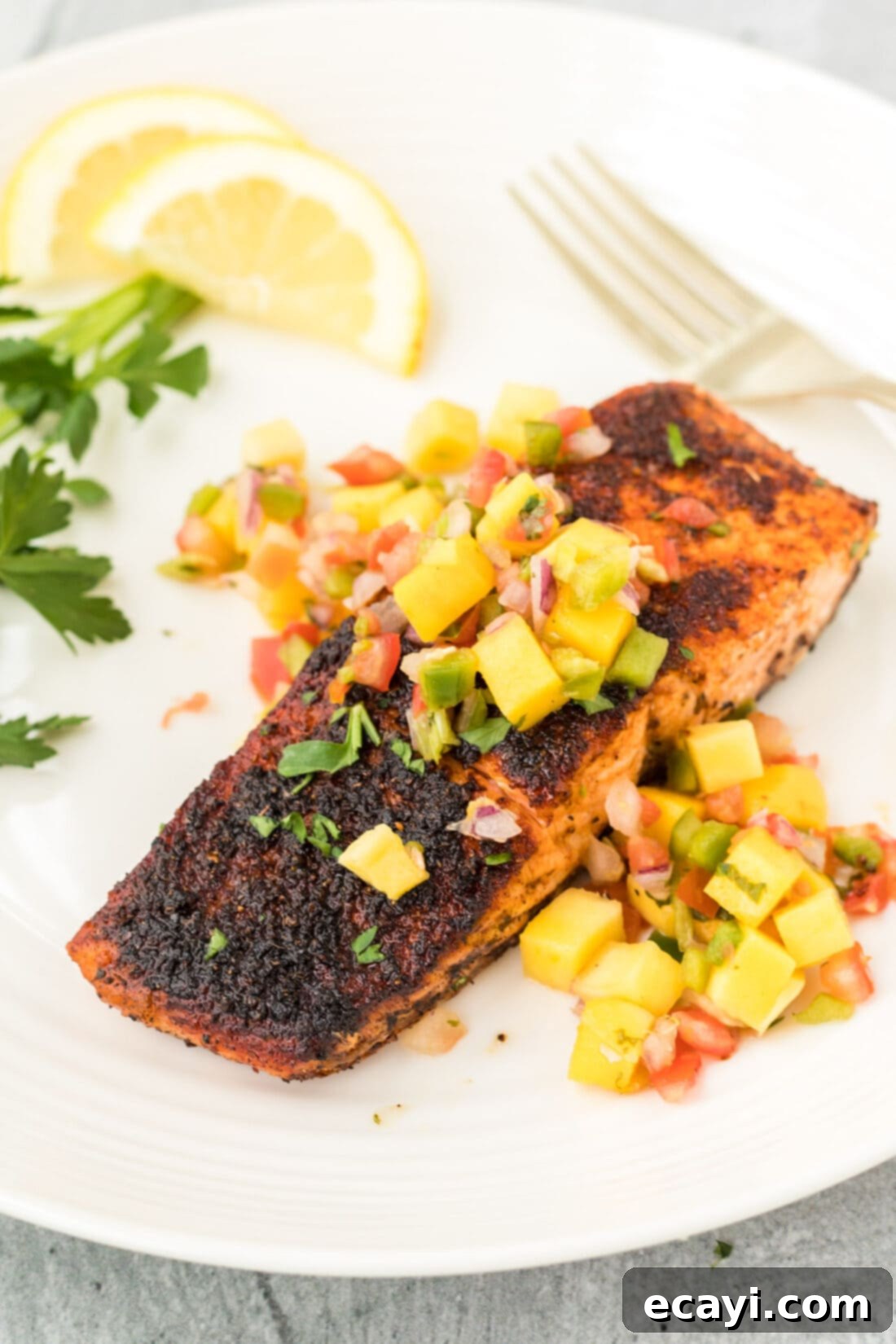
Why This Blackened Salmon Recipe is a Must-Try
This blackened salmon recipe stands out for many excellent reasons. Salmon is widely recognized as one of the best dietary sources of Omega-3 fatty acids, which are crucial for heart health, brain function, and reducing inflammation. Paired with our meticulously crafted, incredibly flavorful spice blend, this dish transforms into a powerhouse of both health and deliciousness. It’s a culinary triumph that proves healthy eating can be truly exciting.
The magic truly happens with the “blackened” seasoning. While it might sound intimidating, conjuring images of burnt food, fear not! Blackening is a distinct cooking technique that involves coating fish or meat generously with a blend of aromatic, bold spices and then searing it at a high temperature in a hot pan, typically cast iron. This process creates a dark, almost charred, crispy crust on the exterior while keeping the inside moist and succulent. The spices toast beautifully, intensifying their flavors and aromas, giving the salmon a depth that is simply unmatched. Just like our popular blackened shrimp, this method elevates the flavor profile to an entirely new level. Once you experience the rich, smoky, and slightly spicy notes of this perfectly pan-seared blackened salmon, you’ll undoubtedly be hooked, making it a regular fixture in your meal rotation.
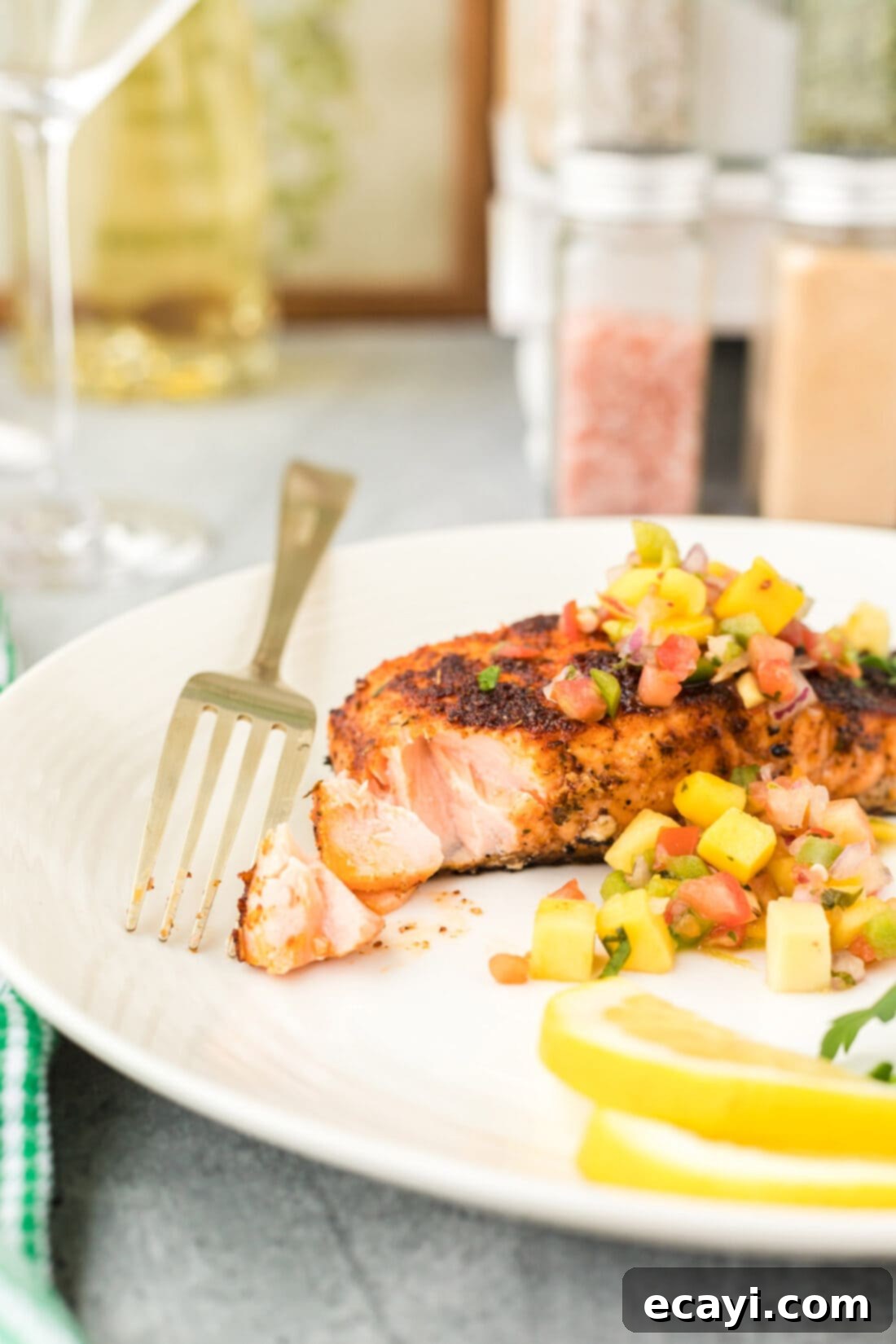
Essential Ingredients for Your Blackened Salmon
To embark on this culinary adventure and create the best blackened salmon you’ve ever tasted, you’ll need a handful of fresh ingredients and pantry staples. All precise measurements, ingredients list, and detailed instructions are available in the convenient printable recipe card located at the conclusion of this comprehensive post. Gathering your ingredients beforehand, a practice known as “mise en place,” will ensure a smooth and enjoyable cooking process.
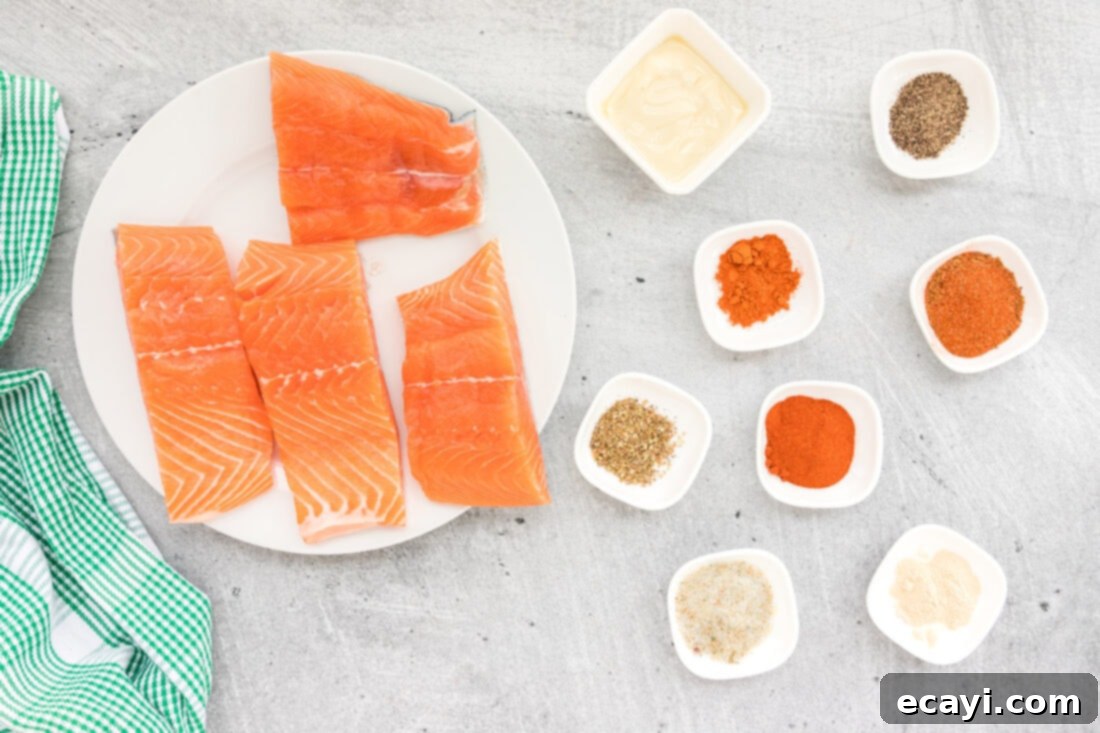
Ingredient Spotlight & Expert Substitution Tips
Understanding your ingredients is key to successful cooking. Here’s a deeper dive into what you’ll need and how to make smart substitutions:
SALMON – For this recipe, we highly recommend using center-cut salmon. This specific cut is the thickest part of the fish, which translates to heavier, more substantial filets with a uniform thickness. Uniform thickness is crucial for even cooking, ensuring all your salmon pieces are perfectly done at the same time. To prepare, use a sharp chef’s knife to slice your salmon filet into approximately four smaller portions, each weighing about 6 ounces. While convenience often leads us to frozen options, for the best texture and flavor, we strongly advise using fresh salmon. If fresh isn’t an option and you must use frozen salmon, be sure to allow it to fully thaw overnight in the refrigerator. Proper thawing prevents the salmon from becoming watery or mushy during cooking, preserving its natural tenderness. When choosing fresh salmon, look for vibrant color, firm flesh, and a mild, fresh scent.
SEASONING – Our signature blackening seasoning blend is a symphony of flavors, comprising Cajun seasoning, onion powder, paprika, dried oregano, garlic salt, black pepper, and cayenne pepper. It’s worth noting that Cajun seasoning and blackened seasoning are often quite similar and can be fairly interchangeable; many store-bought blackened seasoning blends incorporate a Cajun base. The vibrant kick in this spice mixture primarily comes from the cayenne pepper and the Cajun seasoning itself. If you’re not a fan of spicy foods or prefer a milder flavor, you can easily adjust the heat by omitting Cajun seasoning entirely or reducing the amount of cayenne pepper you use. However, we’ve found that the recipe as-is offers a robust flavor without being overwhelmingly spicy. For ultimate convenience, pre-packaged blackened seasoning blends are readily available at most grocery stores, though mixing your own allows for precise control over the flavor profile and ensures maximum freshness.
BUTTER – Softened butter is a critical component in achieving that signature blackened crust. It acts as a binder for the spices, ensuring they adhere well to the fish, and also promotes a beautiful sear and rich flavor. You can use unsalted butter if you prefer to control the sodium content more precisely, especially since garlic salt is already in the seasoning blend. If you’re looking for a dairy-free alternative, margarine can be used, or a high-smoke-point oil like avocado oil, though butter offers a richer flavor and superior browning.
Step-by-Step Guide: Crafting Your Perfect Blackened Salmon
These step-by-step photos and detailed instructions are designed to help you visualize each stage of making this incredible recipe, ensuring your success. For a convenient printable version of this recipe, complete with exact measurements and full instructions, simply Jump to Recipe at the bottom of this post.
- Begin by gently rinsing your salmon filets under cool water. Pat them thoroughly dry with paper towels. Removing excess moisture is a crucial step as it promotes a crispier crust during searing.
- Next, take your softened butter and evenly brush a generous amount over the flesh side of each salmon filet. You won’t use all the butter in this initial step; save the remainder for later. The butter acts as a binder for the seasoning and contributes to the rich crust.
- In a small bowl, combine your spice blend: Cajun seasoning, onion powder, paprika, dried oregano, garlic salt, black pepper, and cayenne pepper. Mix them well until uniformly distributed.
- Now, generously season the buttered flesh side of your salmon filets with this vibrant spice mixture. You want a substantial coating to achieve that authentic blackened flavor and appearance, but be mindful not to apply so much that it simply falls off. The butter should help it adhere beautifully.
- With a pastry brush, lightly dab more softened butter directly on top of the applied seasoning mixture. This extra layer of butter will aid in developing a deep, dark crust and further infuse the flavors during searing. Again, you will not use all the butter at this stage.
- Combine any remaining spice mixture and the rest of the softened butter in a small bowl. This will be used to baste the skin side of the salmon during cooking.
- Place a heavy-bottomed skillet (a cast iron skillet is ideal for blackening) over medium-high heat. Allow it to heat until it’s very hot – almost smoking. This high heat is essential for creating the perfect sear and blackened crust. Carefully add the salmon filets to the hot skillet, placing them skin side up.
- Once the salmon is in the pan, immediately brush the skin side with the remaining butter and seasoning mixture. Cook the filets for approximately 3-4 minutes. During this time, periodically use tongs to gently wiggle the filets a little. This helps to ensure they don’t stick to the pan and promotes an even crust. If you encounter any issues with sticking, a thin fish turner spatula is an excellent tool for lifting the entire filet cleanly. Keep an eye on the edges for signs of cooking through.
- Carefully turn the filets over to the skin side. Continue to cook for another 2-3 minutes, or until the salmon reaches your desired level of doneness. The skin should be crispy and the flesh should be flaky. The total cooking time will vary slightly based on the thickness of your salmon and the exact heat of your skillet.
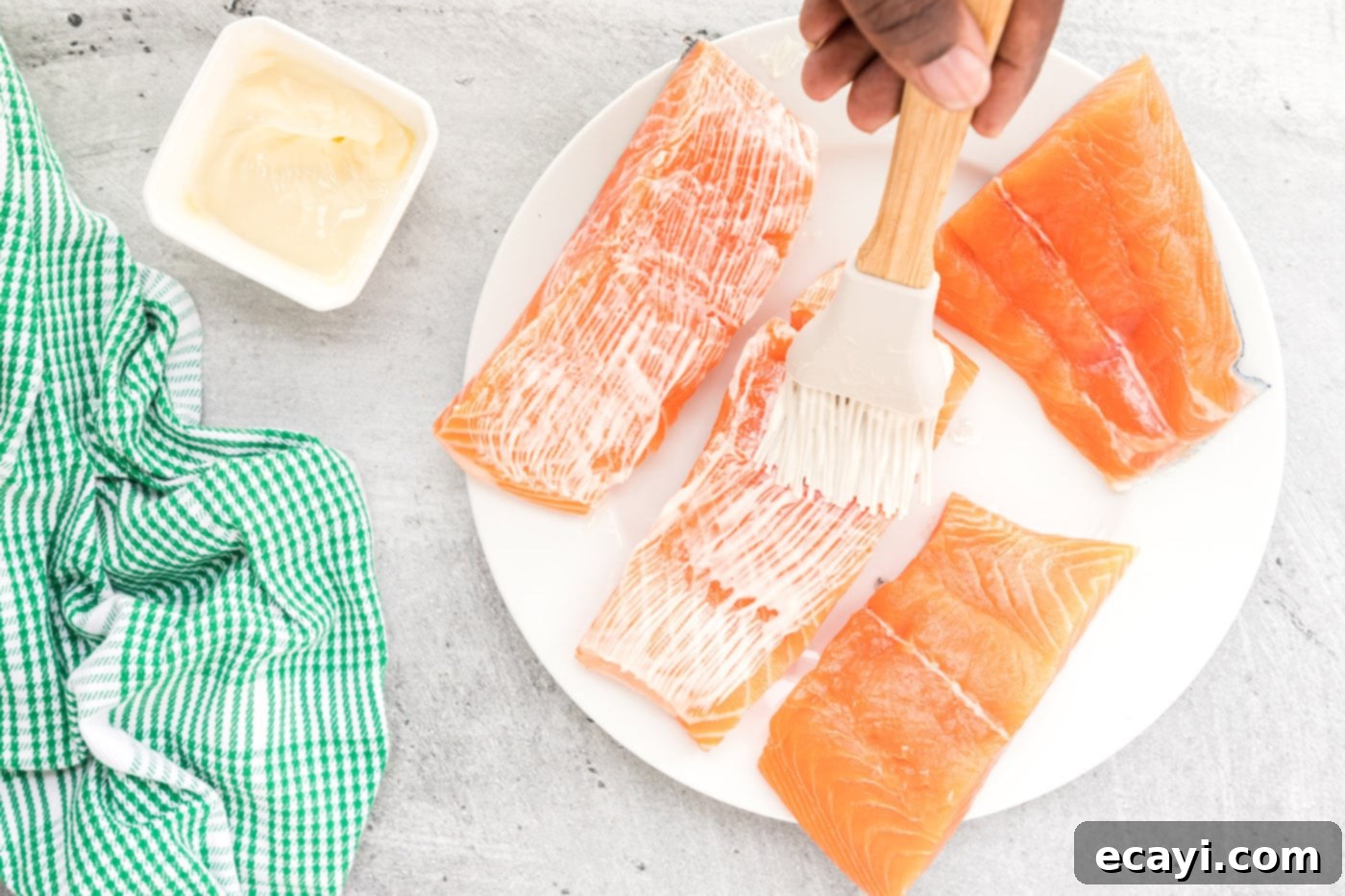
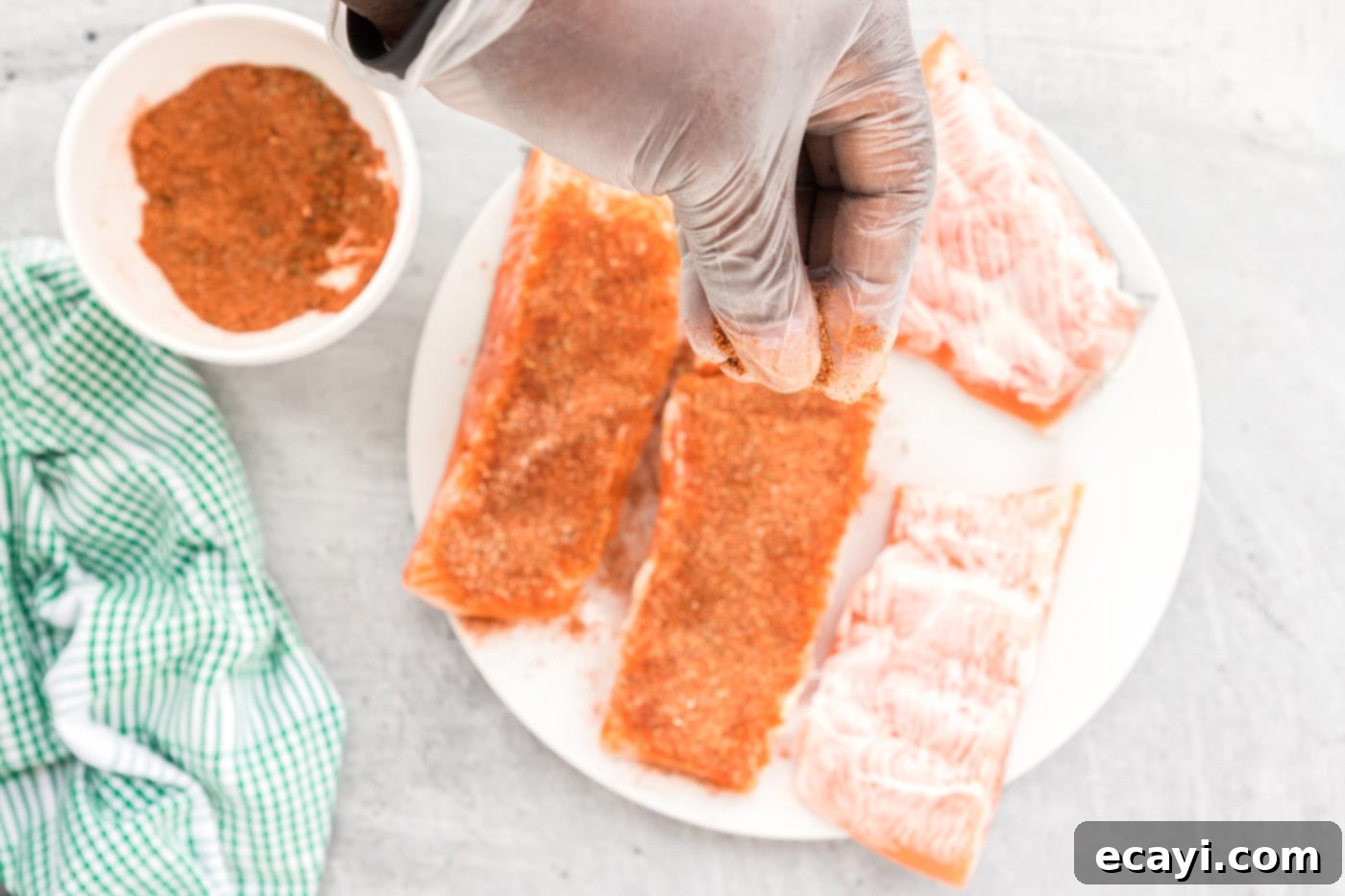
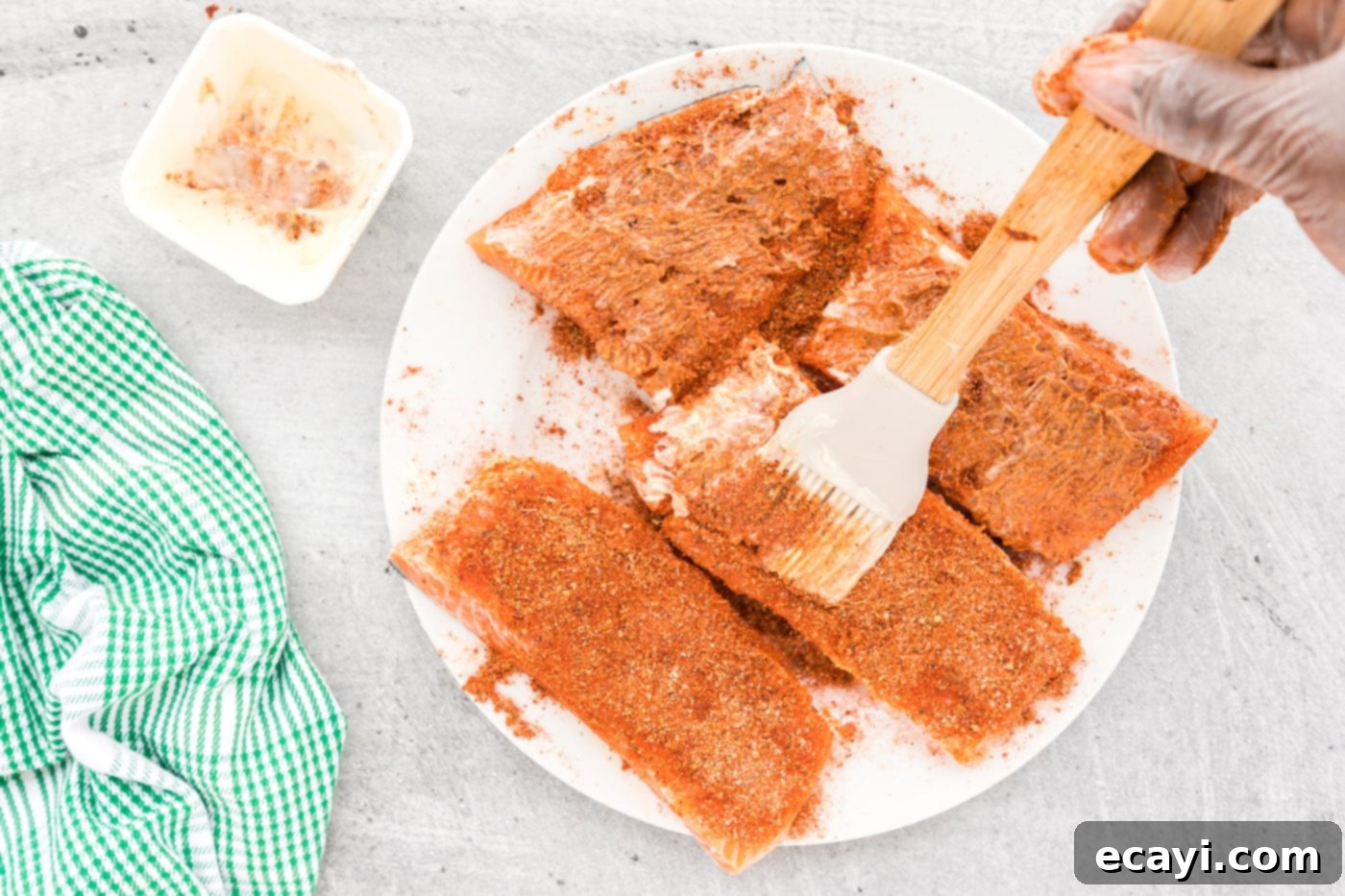
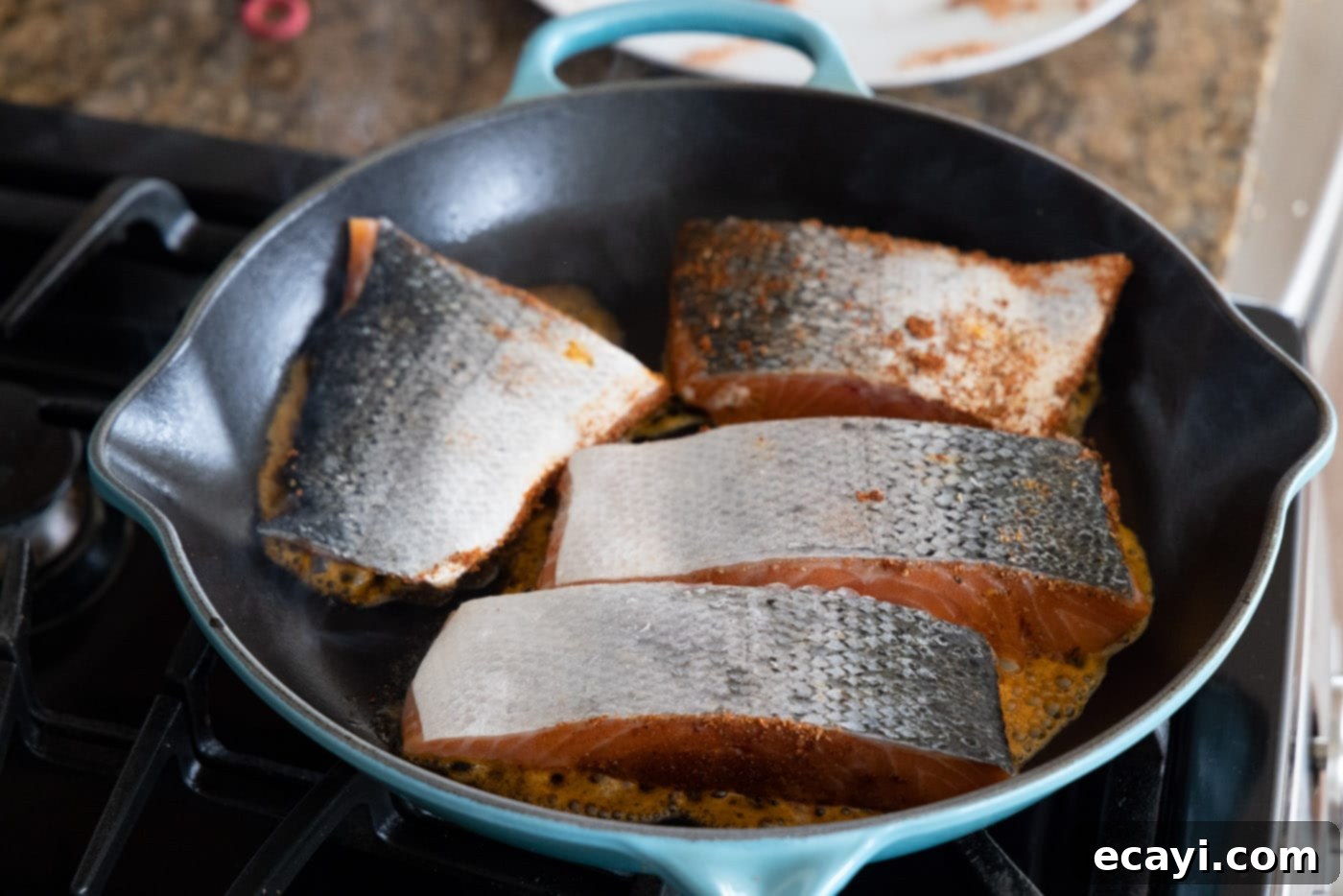
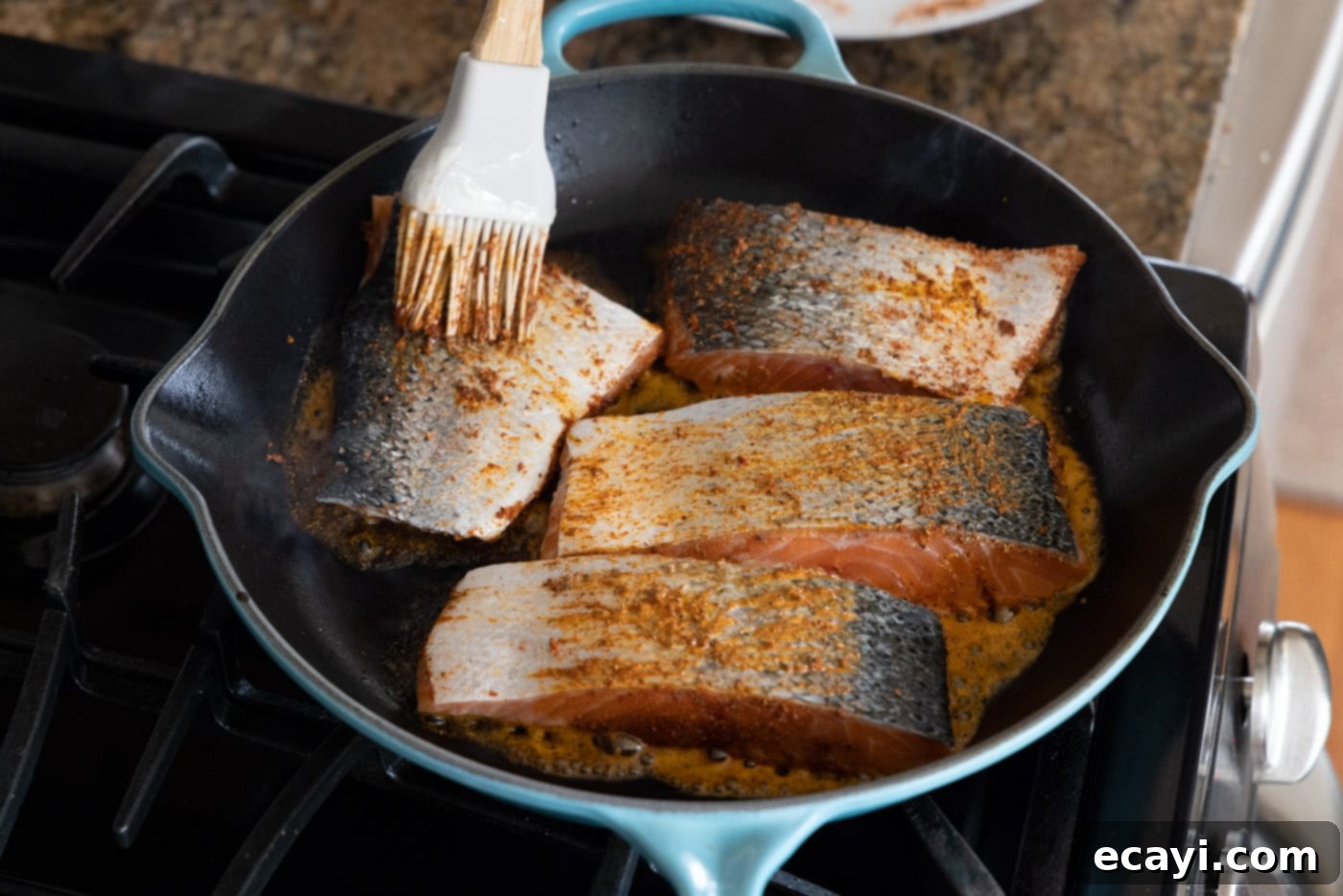
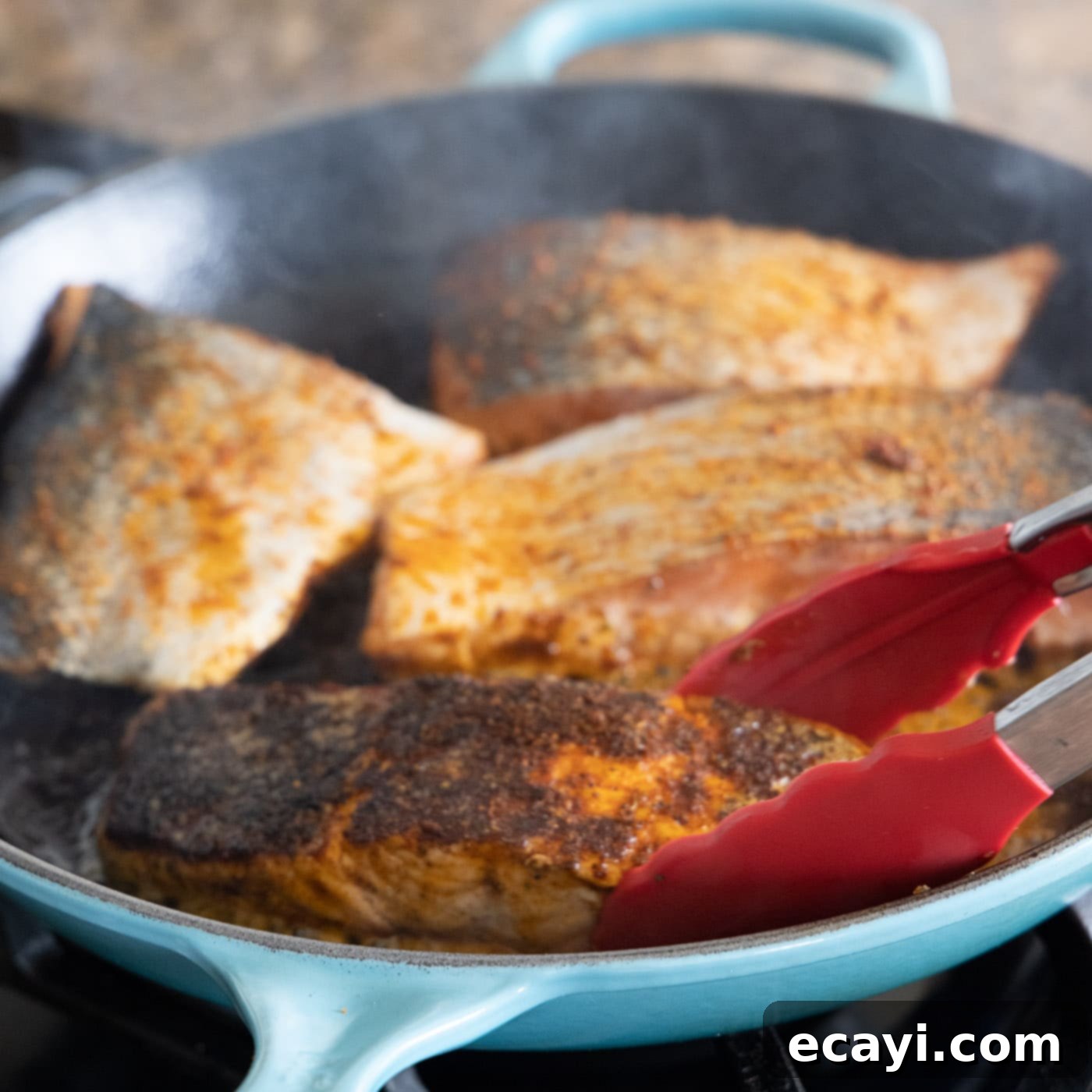
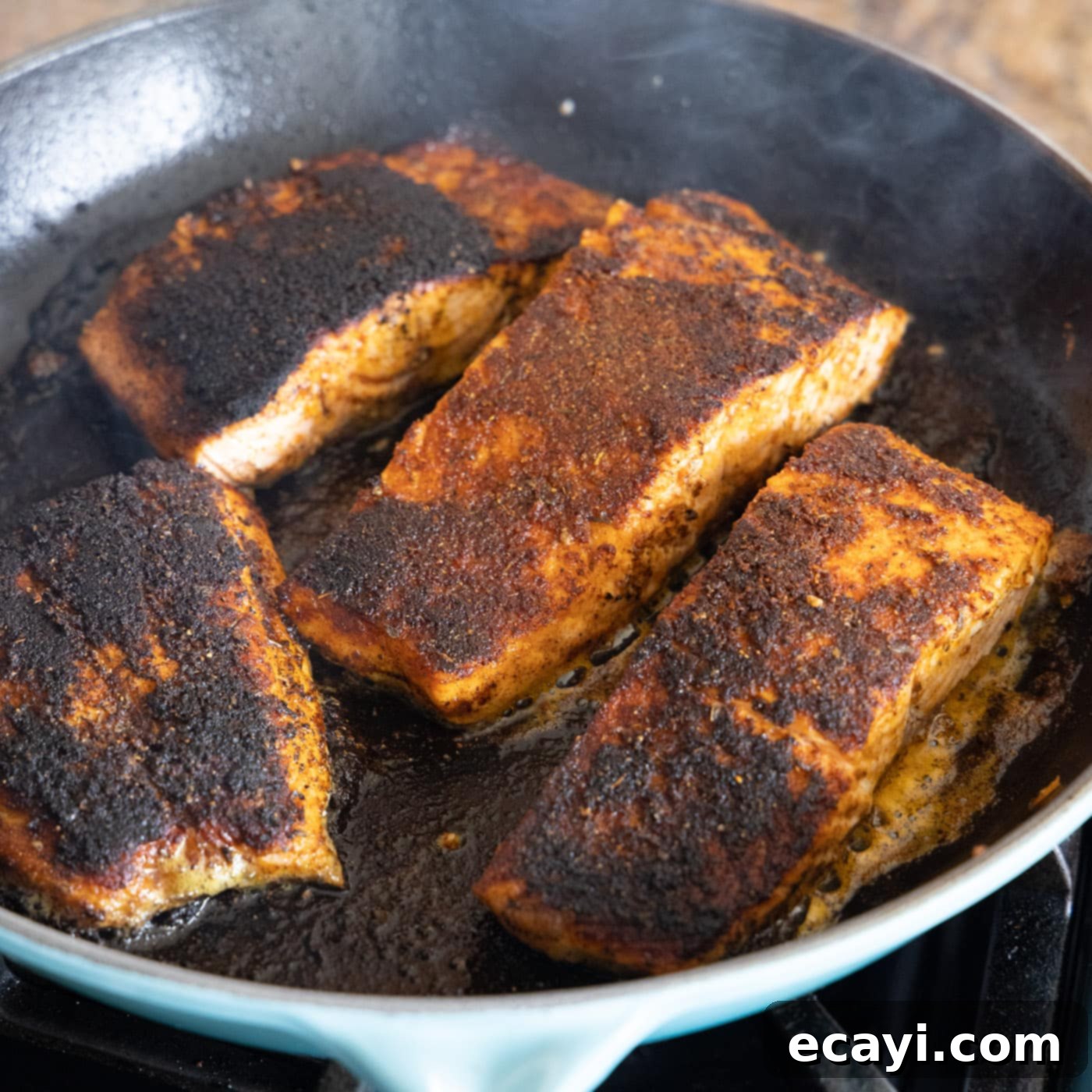
Frequently Asked Questions & Expert Tips for Success
Determining the perfect doneness for salmon is key to a delicious meal. To test your filets, gently press your finger (or the tip of a knife if it’s too hot) onto the top center or the thickest part of the filet. If it begins to flake or separate easily, then it is perfectly cooked. Be cautious not to overcook the filets, as this can result in dry, overly flaky, and less enjoyable salmon. For the most accurate results, you may also use an instant-read thermometer; salmon is typically finished cooking when it reaches an internal temperature of 125-135°F (52-57°C) in its thickest part. Remember that salmon will continue to cook slightly after being removed from the heat (carryover cooking).
Leftover blackened salmon is just as delicious the next day! To store, allow the salmon to cool completely to room temperature. Then, transfer it to an airtight container and keep it in the refrigerator for 2-3 days. This helps maintain its freshness and prevents it from drying out.
While pan-searing is the traditional and recommended method for achieving that perfect blackened crust, you can adapt this recipe for other cooking methods. For a similar effect with less smoke, you can bake it in a very hot oven (around 400-425°F or 200-220°C) for 12-15 minutes, or use an air fryer at 375-400°F (190-200°C) for 8-12 minutes, flipping halfway. Keep in mind that the crust may not be as intense as pan-searing, and cooking times will vary, so always check for doneness.
A heavy-bottomed cast iron skillet is unequivocally the best choice for blackening salmon. Cast iron retains and distributes heat exceptionally well, which is crucial for getting that intense, crispy, and flavorful crust that defines blackened dishes. If you don’t have a cast iron skillet, a heavy stainless steel skillet can work, but ensure it’s heated thoroughly and use slightly more oil or butter to prevent sticking.
Blackening, by nature, produces some smoke due to the high heat and searing of spices. To minimize smoke, ensure your kitchen is well-ventilated. Turn on your exhaust fan to its highest setting, open a window, or even consider cooking outdoors on a side burner if possible. Using a skillet that is hot but not smoking excessively (just before the oil smokes) can also help. A small amount of smoke is normal and part of the process, but good ventilation is key for comfort.
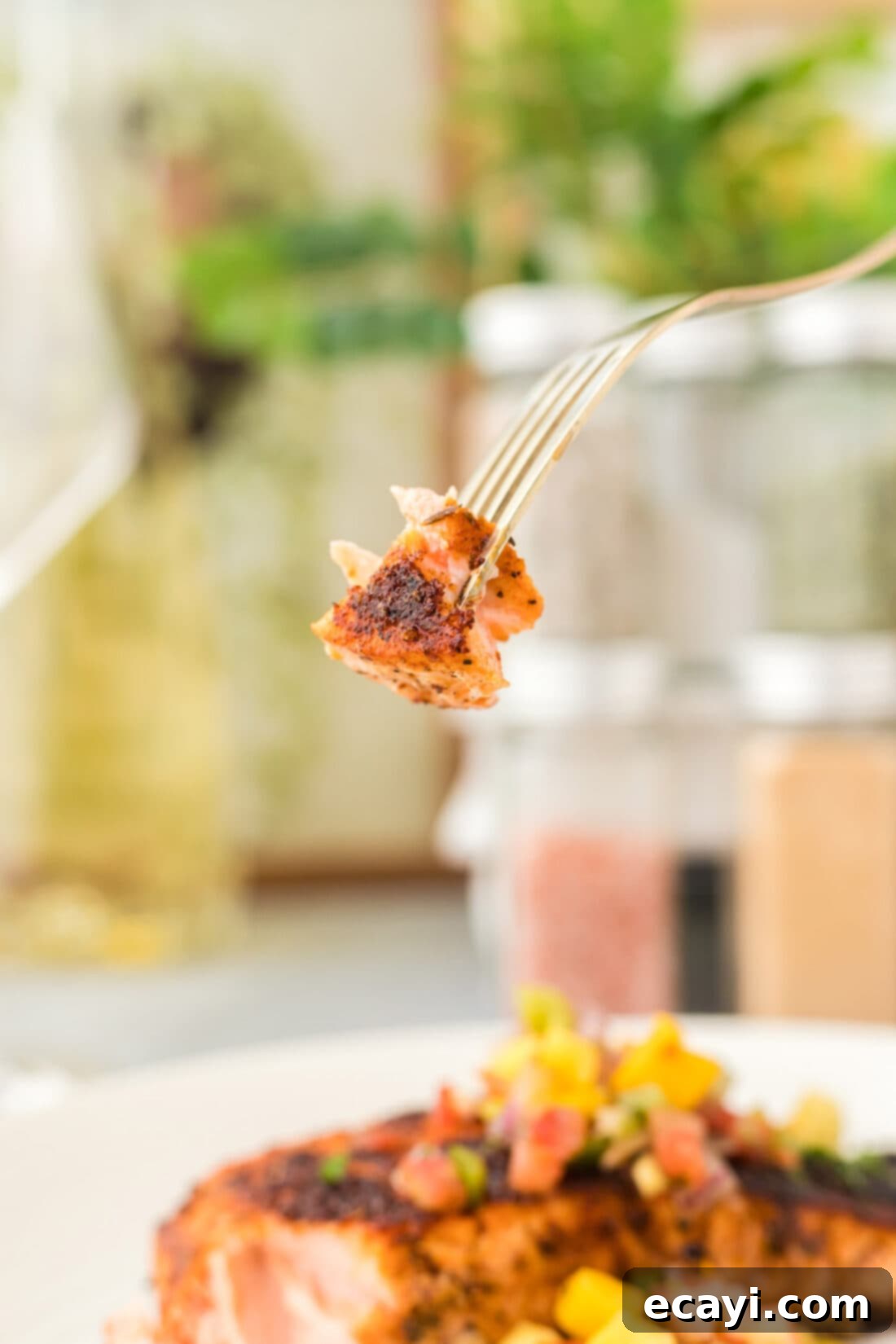
Delicious Serving Suggestions for Blackened Salmon
Blackened salmon is incredibly versatile and pairs wonderfully with a variety of sides and sauces. For a classic and satisfying meal, serve your perfectly cooked salmon with a bed of fluffy white or brown rice and a fresh, crisp side salad. To add more greens and nutrients, consider roasted asparagus, tender green beans, or perfectly steamed or roasted broccoli. These simple sides allow the robust flavor of the salmon to truly shine.
To enhance the experience, you can optionally pair your blackened salmon with a range of delectable sauces or garnishes. A creamy tartar sauce offers a traditional complement, while a rich rosemary cream sauce can elevate the dish to gourmet status. For a bright, tangy finish, simply serve with fresh lemon wedges for dipping, drizzling, or squeezing over the fish. As beautifully illustrated in the accompanying photos, we love pairing ours with a vibrant mango salsa. The sweet and zesty notes of the salsa provide a delightful contrast to the spicy, savory salmon, creating a balanced and exciting flavor profile. Other excellent options include corn on the cob, couscous, quinoa, or even serving it flaked over a Caesar salad for a healthy lunch. For a touch of Southern comfort, consider serving it with collard greens or dirty rice.
Explore More Delicious Salmon Recipes
If you’ve enjoyed this blackened salmon, you’ll love exploring other ways to prepare this incredibly versatile and healthy fish. Salmon is a culinary delight, offering endless possibilities for delicious meals. Dive into some of our other favorite salmon recipes:
- Baked Salmon: A simple yet elegant classic, perfect for any occasion.
- Lemon Salmon: Bright and zesty, this recipe highlights salmon’s natural flavors with a citrusy twist.
- Maple Soy Salmon: A delightful blend of sweet and savory, offering an Asian-inspired flavor profile.
- Cedar Plank Salmon: For a smoky, aromatic experience, this grilling method is a game-changer.
- Instant Pot Salmon: Quick and convenient, perfect for busy weeknights without sacrificing flavor.
- Dijon Lemon Caper Salmon: A sophisticated and tangy dish, ideal for impressing guests.
I absolutely adore spending time in the kitchen, experimenting with new flavors, and perfecting beloved classics. Sharing my cooking and baking experiences with all of you brings me immense joy! Remembering to come back to the blog each day for new inspiration can sometimes be a challenge, which is why I offer a convenient newsletter delivered straight to your inbox every time a new recipe posts. Simply subscribe today and start receiving your free daily recipes, ensuring you never miss out on your next favorite meal!
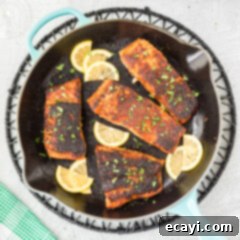
Blackened Salmon
IMPORTANT – There are often Frequently Asked Questions and Expert Tips within the blog post that you may find incredibly helpful. Simply scroll back up to read them!
Print It
Pin It
Rate It
Save ItSaved!
Ingredients
- 1 ½ pounds center cut salmon cut into 4 filets
- 3 Tablespoons butter well softened, or margarine
- 1 Tablespoon Cajun seasoning
- ½ Tablespoon onion powder
- ½ teaspoon paprika
- ½ teaspoon dried oregano
- 2 teaspoons garlic salt
- ½ teaspoon black pepper
- ½ teaspoon cayenne pepper
Things You’ll Need
-
Large heavy bottomed skillet
-
Pastry brush
-
Vinyl gloves
-
Fish turner or tongs
Before You Begin & Expert Tips
- Using tongs to gently wiggle the filets during cooking will significantly help to ensure they don’t stick to the pan. If you find the salmon is particularly adherent, a wide, thin fish turner spatula is an excellent tool for lifting the entire filet at once without breaking it.
- We recommend using center-cut salmon because it’s the thickest part of the fish, which yields heavier and more uniformly thick filets. This consistency is important for even cooking and a more satisfying portion.
- To accurately test your salmon filets for doneness, gently press your finger (or the tip of a knife if it’s too hot) onto the top center or the thickest part of the filet. If it begins to flake or separate easily, it’s done. Be careful not to overcook, as this will result in dry and overly flaky salmon. An instant-read thermometer provides the most precise measure; salmon is perfectly cooked when it reaches an internal temperature of 125-135°F (52-57°C) in the thickest part of the filet.
- Ensure your skillet is very hot before adding the salmon. This high heat is essential for creating the blackened crust and preventing the fish from steaming instead of searing.
- Good ventilation is recommended when blackening as high heat and spices can produce smoke. Turn on your kitchen fan or open a window.
Instructions
-
Rinse the salmon filets under cool water and pat them thoroughly dry with paper towels to ensure a crispy crust.
-
Brush the flesh side (the side without skin) of the salmon filets generously with softened butter. Set aside some butter for later steps.
-
In a small bowl, combine the Cajun seasoning, onion powder, paprika, dried oregano, garlic salt, black pepper, and cayenne pepper to create your signature spice mixture.
-
Season the buttered flesh side of the salmon filets heavily with the prepared spice mixture. Ensure a generous coating, making sure the spices adhere well to the butter and don’t fall off.
-
Using a pastry brush, dab a little more butter on top of the seasoning mixture on the flesh side. You’ll still have some butter remaining.
-
Combine any remaining spice mixture and the rest of the softened butter together in a small bowl. This blend will be used for the skin side.
-
Heat a heavy-bottomed skillet (preferably cast iron) over medium-high heat until it is very hot. Carefully add the salmon filets to the hot skillet, placing them skin side up.
-
Brush the skin side of the salmon with the remaining butter/seasoning mixture. Cook the filets for about 3-4 minutes. Use tongs to gently wiggle the filets occasionally to prevent sticking.
-
Carefully turn the filets over to the skin side and cook for another 2-3 minutes, or until the salmon is cooked through and flakes easily.
Nutrition
The recipes on this blog are tested with a conventional gas oven and gas stovetop. It’s important to note that some ovens, especially as they age, can cook and bake inconsistently. Using an inexpensive oven thermometer can assure you that your oven is truly heating to the proper temperature. If you use a toaster oven or countertop oven, please keep in mind that they may not distribute heat the same as a conventional full sized oven and you may need to adjust your cooking/baking times. In the case of recipes made with a pressure cooker, air fryer, slow cooker, or other appliance, a link to the appliances we use is listed within each respective recipe. For baking recipes where measurements are given by weight, please note that results may not be the same if cups are used instead, and we can’t guarantee success with that method.
